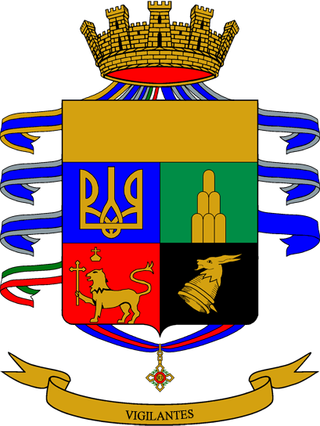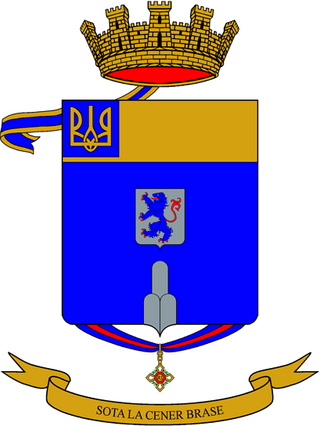
The 2nd Alpini Regiment is a mountain warfare regiment of the Italian Army based in Cuneo in Piedmont. The regiment belongs to the Italian Army's Alpini infantry speciality and is assigned to the Alpine Brigade "Taurinense". On 1 November 1882, the Royal Italian Army formed the 2nd Alpini Regiment, which had its recruiting area in the Maritime Alps and Cottian Alps. During World War I the regiment expanded to ten battalions, which fought separately in the alpine areas of the Italian front.

The 1st Alpini Regiment in a mountain warfare unit of the Italian Army based in Turin in Piedmont. The regiment belongs to the Italian Army's Alpini infantry speciality and was last active as Alpini Battalion Mondovì. On 1 October 2022, the flag and traditions of the 1st Alpini Regiment were assigned to the Command and Tactical Supports Unit "Taurinense" of the Alpine Brigade "Taurinense", which on the same day was renamed 1st Alpini Command and Tactical Supports Unit. On 1 November 1882, the Royal Italian Army formed the 1st Alpini Regiment, which had its recruiting area in the Ligurian Alps and Maritime Alps. During World War I the regiment expanded to nine battalions, which fought separately in the alpine areas of the Italian front.

The 3rd Alpini Regiment is a mountain warfare regiment of the Italian Army based in Pinerolo in Piedmont. The regiment belongs to the Italian Army's Alpini infantry speciality and is assigned to the Alpine Brigade "Taurinense". On 1 November 1882, the Royal Italian Army formed the 3rd Alpini Regiment, which had its recruiting area in the Cottian Alps and Graian Alps. During World War I the regiment expanded to 13 battalions, which fought separately in the alpine areas of the Italian front.

The 4th Alpini Paratroopers Regiment is a special operations forces regiment of the Italian Army based in Montorio Veronese in Veneto. Originally the regiment belonged to the Italian Army's Alpini infantry specialty, but since 14 July 1996 its personnel also belongs to the Paratroopers infantry specialty. On 1 November 1882, the Royal Italian Army formed the 4th Alpini Regiment, which had its recruiting area in the Graian Alps and Pennine Alps. Since 2013 the regiment is assigned to the Army Special Forces Command. The regiment is one of the most often and one of the highest decorated regiments of the Italian Army, although its two Gold Medals of Military Valor were awarded to the regiment's currently inactive Alpini Battalion "Aosta", respectively the currently active Battalion "Monte Cervino".

The 5th Alpini Regiment is a mountain warfare regiment of the Italian Army based in Sterzing in South Tyrol. The regiment belongs to the Italian Army's Alpini infantry speciality and is assigned to the Alpine Brigade "Julia". On 1 November 1882, the Royal Italian Army formed the 5th Alpini Regiment, which had its recruiting area in the valleys of Northern Lombardy, which lie mostly within the Lepontine Alps, Bergamasque Alps and Livigno Alps. The recruiting area of the 5th Alpini Regiment extended to the Westerns shore of Lake Garda, with the recruiting area of the 6th Alpini Regiment commencing on the Eastern shore.

The 6th Alpini Regiment is a mountain warfare training regiment of the Italian Army based in Bruneck in South Tyrol. The regiment belongs to the Italian Army's Alpini infantry speciality and is assigned to the Alpine Training Center in Aosta. On 1 November 1882, the Royal Italian Army formed the 6th Alpini Regiment, which had its recruiting area initially in the Vicentine Alps, Bellunes Alps, Carnic Alps, Carnic Prealps, and the Western side of the Julian Alps. In 1887 the regiment was split to form the 7th Alpini Regiment and afterwards the regiment's recruiting area consisted of the Vicentine Alps.

The 8th Alpini Regiment is a mountain warfare regiment of the Italian Army based in Venzone in Friuli-Venezia Giulia. The regiment belongs to the Italian Army's Alpini infantry speciality and is assigned to the Alpine Brigade "Julia". On 1 October 1909, the Royal Italian Army formed the 8th Alpini Regiment by splitting the 7th Alpini Regiment. The new regiment's recruiting area consisted of the Carnic Alps, Carnic Prealps, and the Western side of the Julian Alps. During World War I the regiment expanded to ten battalions, which fought separately in the alpine areas of the Italian front.

The 9th Alpini Regiment is a mountain warfare regiment of the Italian Army based in L'Aquila in Abruzzo. The regiment belongs to the Italian Army's Alpini infantry speciality and is assigned to the Alpine Brigade "Taurinense". The regiment was formed by the Royal Italian Army on 1 July 1921. In 1935 the regiment was assigned to the 3rd Alpine Division "Julia", with which it served during World War II in the Greco-Italian War, during which the division suffered heavy losses. For its service and sacrifice on the Greek Front the 9th Alpini Regiment was awarded Italy's highest military honor the Gold Medal of Military Valor. In summer 1942 the division was transferred to the Eastern Front in the Soviet Union, where it was destroyed in winter 1942-43 during the Soviet Operation Little Saturn. The remnants of the division were repatriated in spring 1943. For its service and sacrifice on the Eastern Front the 9th Alpini Regiment was awarded a second Gold Medal of Military Valor. On 8 September 1943, the Armistice of Cassibile was announced and invading German forces disbanded the 9th Alpini Regiment.

The Alpini Paratroopers Battalion "Monte Cervino" is a Special Forces unit of the Italian Army. The battalion belongs to the Italian Army's Alpini infantry speciality and is assigned to the 4th Alpini Paratroopers Regiment. In November 1915, the Royal Italian Army's 4th Alpini Regiment formed the Alpini Battalion "Monte Cervino", which served during World War I on the Italian front. For its conduct and valor during the war the battalion, which was disbanded in 1919, was awarded a Silver Medal of Military Valor.

The 2nd Mountain Artillery Regiment is an inactive mountain artillery regiment of the Italian Army, which was based in Trento in Trentino. The regiment was formed in 1915 by the Royal Italian Army as 3rd Mountain Artillery Regiment. In World War I the regiment's groups and batteries served on the Italian front.

The 12th Alpini Regiment is an inactive mountain warfare regiment of the Italian Army last based in Pieve di Cadore in Veneto. The regiment belongs to the Italian Army's Alpini infantry speciality and was assigned to the Alpine Brigade "Cadore". The regiment was formed in 1992 and consisted of the Alpini Battalion "Pieve di Cadore", whose flag and traditions it inherited.

The 18th Regiment "Edolo" is an inactive mountain warfare regiment of the Italian Army last based in Meran in South Tyrol. The regiment belongs to the Italian Army's Alpini infantry speciality and was a training unit last assigned to the Alpine Troops Command. The regiment was formed in 1997 and consisted of the Alpini Battalion "Edolo", whose flag and traditions it inherited.

The 16th Regiment "Belluno" is an inactive mountain warfare regiment of the Italian Army last based in Belluno in Veneto. The regiment belongs to the Italian Army's Alpini infantry speciality and was a training unit last assigned to the Alpine Troops Command. The regiment was formed in 1991 and consisted of the Alpini Battalion "Belluno", whose flag and traditions it inherited.

The 15th Alpini Regiment is an inactive mountain warfare regiment of the Italian Army last based in Chiusaforte in Friuli-Venezia Giulia. The regiment belongs to the Italian Army's Alpini infantry speciality and was assigned to the Alpine Brigade "Julia". The regiment was formed in 1992 and consisted of the Alpini Battalion "Cividale", whose flag and traditions it inherited. The regiment's anniversary falls on 5 January 1943, the day of the Battle of Novaya Kalitva in the Soviet Union.

The 14th Alpini Regiment in a mountain warfare unit of the Italian Army based in Udine in Friuli-Venezia Giulia. The regiment belongs to the Italian Army's Alpini infantry speciality. The regiment was formed in 1993 and consisted of the Alpini Battalion "Tolmezzo", whose flag and traditions it inherited. The regiment was disbanded in 2005. On 1 October 2022, the flag and traditions of the 14th Alpini Regiment were assigned to the Command and Tactical Supports Unit "Julia" of the Alpine Brigade "Julia", which on the same day was renamed 14th Alpini Command and Tactical Supports Unit.

The 2nd Alpine Division "Tridentina" was a division of the Royal Italian Army during World War II, which specialized in mountain warfare. The Alpini that formed the divisions are a highly decorated and elite mountain corps of the Italian Army comprising both infantry and artillery units. The name Tridentina was chosen as the division was based in the Trentino-South Tyrol region, for which the fascist regime of Benito Mussolini had created the neologism Venezia Tridentina. After World War II, the traditions and name of the 2nd Alpine Division "Tridentina" were carried on by the Alpine Brigade "Tridentina".

The Alpini Battalion "Val Chiese" is an inactive mountain warfare battalion of the Italian Army based last in Sterzing in South Tyrol. The battalion belongs to the Italian Army's Alpini infantry speciality and was assigned to the Alpine Brigade "Orobica". In 1915, the Royal Italian Army's 5th Alpini Regiment formed the Alpini Battalion "Val Chiese", which fought in World War I in the alpine areas of the Italian front. The battalion was disbanded in 1919.

The Alpini Battalion "L'Aquila" is a mountain warfare regiment of the Italian Army based in L'Aquila in Abruzzo. The regiment belongs to the Italian Army's Alpini infantry speciality and is assigned to the 9th Alpini Regiment. In 1935, the Royal Italian Army's 9th Alpini Regiment formed the battalion in the city of Gorizia.

The Mountain Artillery Group "Asiago" is an inactive mountain artillery group of the Italian Army, which was based in Toblach in South Tyrol. The group consisted of mountain artillery batteries, had been formed in December 1914 and served in World War I on the Italian front. During World War II the batteries were assigned to the Alpine Artillery Group "Val Camonica" of the 2nd Alpine Artillery Regiment "Tridentina", which distinguished itself on the Eastern Front. The Mountain Artillery Group "Asiago" was formed in 1952 and assigned to the 2nd Mountain Artillery Regiment of the Alpine Brigade "Tridentina". In 1975 the group became an autonomous unit and was granted a flag and coat of arms. After the end of the Cold War the group was disbanded in 1991.
The Alpini Battalion "Val Cismon" is an inactive mountain warfare battalion of the Italian Army based last in San Stefano di Cadore in Veneto. The battalion belongs to the Italian Army's Alpini infantry speciality and was assigned to the Alpine Brigade "Cadore". In 1915, the Royal Italian Army's 7th Alpini Regiment formed the Alpini Battalion "Val Cismon", which fought in World War I in the alpine areas of the Italian front. The battalion was disbanded in 1919.





















